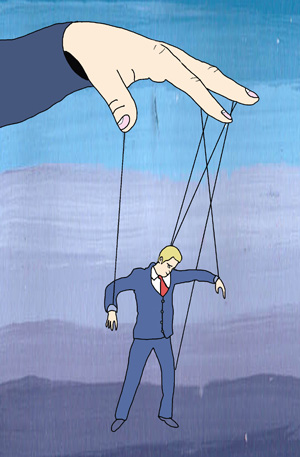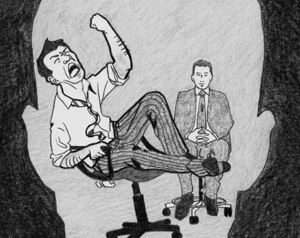
Your complimentary articles
You’ve read one of your four complimentary articles for this month.
You can read four articles free per month. To have complete access to the thousands of philosophy articles on this site, please
Free Will
The Brain’s Risk/Reward System Makes Our Choices, Not Us
Graham W. Boyd argues that choice is an illusion.
“Recently I was trying to explain to an intelligent woman the problem of trying to understand how it is we perceive anything at all, and I was not having any success. She could not see why there was a problem. Finally in despair I asked her how she herself thought she saw the world. She replied that she probably had somewhere in her head something like a little television set. ‘So who,’ I asked ‘is looking at it?’ She now saw the problem immediately.” F.H. Crick, in Scientific American, 1979
The first question to be answered is: Who or what is running the show? In Part 1 I will attempt to explain human decision-making without the need for a hidden homunculus. Part 2 will then go on to look at how the brain can operate within this environment to generate the impression of an individual being driven by a highly conscious self.
The arguments over what has become known as the ‘mind-body problem’ go back at least to René Descartes’ Seventeenth Century dualist view that there’s ‘mind stuff’ and ‘body stuff’ and the two are quite separate, the mind stuff being ethereal. In the face of all the neuroscience data accumulated since Descartes’ time, I view this as a truly embarrassing stance to take in the Twenty-First Century, so the first part of this article will be concerned with seeing if we can get around it. I think we can. My approach is a tad autocratic and the conclusion equally radical, so be warned.
Let’s look first look at how the brain makes its decisions.
Part 1: DECISIONS

BASE jumping: The emotional brain in action
Sam Laming BASE jumping Beachy Head © Sam Laming. See facebook.com/layingonthesky
There are two major ways of processing information facilitated by the human brain. I hold that all decisions are made by a risk/reward comparison of the incoming sensory information within the emotional brain (‘System 1 thinking’) rather than within the rational brain (‘System 2 thinking’). System 1, the emotional system for processing sensory information and generating responses to it according to a risk or reward weighting, is automatic, intuitive, and fast, even impulsive. System 2 is the rational, slow, and controlled system of thought, where we reason through our options. (For more about these systems of thought, see Thinking Fast and Slow, Daniel Kahneman, 2011.)
Tucked away in the centre of the brain, System 1 monitors the environment one way or another to minimize risk to survival and maximize reward. Feedback continually updates the system about the environment. The emotional response system evaluates all the incoming sensory information, and then scores it for a ‘winner-takes-all’ competition to decide on the best response. My contention in this article is that System 1 interacting with incoming sensory information runs everything. There is no room for any homunculus here.
The details of the process are intriguing. All incoming sense data are converted into a ‘common cerebral currency’, placed into context, assessed for their predicted risk or reward value in the emotional brain, and the likely error of that assessment. The results are then ranked in what I have dubbed emotion scores, to allow disparate information to be compared until a successful competitor for stimulating a response emerges within the system. This decision and choice mechanism is quantitatively quite precise (see my On Stress Disease and Evolution: A Unifying Theory, 2012, to see just how precise: eprints.utas.edu.au/12671/).
Not a bad start? Then welcome to the world of System 1. But of course you will now go and spoil things by asking: ‘What about the capacity for rational thought? Can that be accommodated within this way of thinking?’
Well, actually, yes it can, but in a rather complex way.
The Rational Brain
It is now clear that the two systems for decision-making in man operate so-called ‘dual process monitoring’ (see for instance De Neys and Glumicic in Cognition Vol. 106, 2008). I see the mechanism for this dual processing being as follows. If at any time a certain threshold for alerting System 1 is not exceeded, judgement is withheld, and the more deliberative, rational System 2 may come into play. Nonetheless, the intuitive, emotional system still tends to strongly dominate. De Neys and Glumicic have found that subjects struggle to override the instinctive emotional risk/reward brain responses, since rational thought options often do not receive enough cerebral ‘weight’ to prevail over the choices of the emotional brain.
My suggestion for how to understand that is as follows. The emotional brain always harvests the best option for response as the one having the highest risk/reward emotion score, whether this score is derived primarily from the emotional brain, or indirectly via the rational brain. If nothing above a certain threshold is produced from the primary analysis of the incoming sensory information by the emotional system, then analysis is switched to the slower deliberations of the rational system. But – and here’s the rub – the eventual risk/reward score calculated is not estimated primarily through a ‘rational ranking’, but rather, is based on the risk/reward value of that response to the emotional brain. Moreover, because of the way the brain works, the emotional score of rational deliberations is likely to often be less than rating from any analysis primarily through the emotional system. In effect then: Rational options are chosen if and only if the emotion scores they evoke in the evaluation of the emotional brain are high enough to beat the scores of any more intuitive competitor responses.

Determinism Rules © Jack Hodges 2016 Please visit jackhodges.tumblr.com
The situation here is complex. It takes time and trouble to allocate emotional risk/reward scores to rational system response options so that they can compete in the emotional brain. Actually, given the magnitude and complexity of the task involved, the wonder is that rational options ever manage to get converted into having competitive emotional risk/reward scores at all. All that the rational system would have to go on would be past experience; and at best, that would merely be analogous to any present situation rather than precisely the same – meaning that the process of converting rational options to emotional risk/reward options will often lead to an underestimation of their persuasiveness. By contrast, the emotional brain has an innate strength and creates correspondingly strong options because of its long evolutionary history of development to aid survival. This system is not easily overcome. This would explain why deliberations about rational options often carry less ‘weight’. In effect, System 2 is generally less ‘assertive’. It is also circumspect, and lazy (see Kahneman, p.44).
The upshot of all this is that if any assessment of any situation by the emotional brain scores above threshold at first pass, it decides the response without deliberation being required. But if not, an option on the same information through the rational mode of thought can still occasionally win on being converted back to a emotional brain score. Its emotional score can improve with experience and training to eventually prevail in specific cases. This is what learning logic is all about. For example, once it has learned the value of Venn diagrams in solving some logic problems, the rational brain can use Venn diagram thinking in others. So the rational brain may be less assertive, but aspects of it may be more trainable than emotional brain processes, causing them to eventually dominate and be preferred in particular cases. However I hold that, in the end, they will be useful in reaching decisions only if they have enough ‘appeal’ in the emotional brain to outbid their more intuitive rivals. Put another way – whether we like it or not, we choose rational options only insofar as they are judged to be potentially more emotionally rewarding than their intuitive rivals – in essence, only if our rational deliberations ‘feel’ better. (Of course, rational options can be of value in making decisions even when they merely inform the intuitive decision-making process.)
Let’s take a breath, because this point about the emotion scoring of rational options is not easy, and I want to make sure it is grasped. The whole emotion scoring system I’ve described I see as being eventually based entirely on the long-established evolutionarily-derived intuitive, risk-reward emotional information-processing system 1. Everything would be a lot simpler if options could be ranked for their rationality, and then allowed to compete directly with intuitive options from the emotional system. But that is not how it works: the only scoring system available is that based on the emotional responses evoked within the risk/reward system, so options arising from the rational system need to have their rational scores converted to emotional scores before they can compete. In the situations described, they occasionally do; but overall, “the emotional tail wags the rational dog” (Kahneman, p.140). Incidentally, there is no reason to think that any of this evaluation need be carried out at a conscious level.
Autonomy of Decision-Making
All this bears directly on the question: ‘Can the whole system run autonomously – that is, with our responses, even our thoughts, being determined entirely by the sensory input interacting with the emotional brain?’
Indeed it can. The brain has no need of any homunculus or remote-control television viewer to drive it. And that is by far and away the most important conclusion I have to offer here.
So how come it all looks so much otherwise – so much as if we are in control of our reactions as conscious selves? Let me now try to convince you that the self is an artificial construct – that self-consciousness is the product of the brain interacting with incoming information in the way I’ve just discussed, and that all this together gives the false impression of primary consciousness with an active self in charge.
Part 2: CONSCIOUSNESS AND THE SELF
Following Benjamin Libet’s seminal studies (originally published in Behavioral & Brain Sciences Vol.8, 1985), it is clear that consciousness is late on the scene of any brain activity. This means that consciousness is an epiphenomenon: it is produced by brain activity, but does not itself influence brain activity. Given this, I suggest that final decisions from the brain are simply fed into a construct we call the self.
All gets a bit complicated here, so let’s look at the self first.
The Self
There are generally held to be two sorts of selves: the bodily self, or ‘self-as-object’; and the first-person self, the ‘inner I’, the 'self-as-subject’– supposedly the self in active charge of everything – meaning that the individual experiences that the highest linguistic deliberations of the brain are referred for output to this inner self-construct ‘as if’ to an active self-as-subject. However, I suggest that this first person self-as-subject construct is not at all actively in charge of volition, attention and decision-making in the way we experience and so profoundly believe it to be. Instead, culture, especially language, play a large part both in this self’s development and in our illusion that it has control.
The way I see everything developing is as follows.
As the child matures and gets a grasp of language, society expects her to be accountable for her actions – a controlling ‘self-as-subject.’ But there is no such active self controlling everything: the brain’s conscious output is determined entirely by the competitive risk/reward emotion-scoring system(s) I described. Above this, there remains only the individual with her passive inner self-construct – that is her experience of being a self that has been created through other brain activity. Nonetheless, given social pressure, the child must respond ‘appropriately’. She does so in the only way she can – by unwittingly allowing her passive inner self-construct be formed as if it were the active self in charge. Again though, the apparently active nature of this newly deemed ‘self-as-subject’ is illusory. There is no inner active self driving thought and behaviour – just a passive inner self-construct to which all of the higher brain’s language-based output (including ‘rational choice’) is referred for ‘ownership’ to make it seem that there is, and in the process satisfy social expectations.
Self-Consciousness

Mind Conference © Peter Pullen 2016 Please visit www.peterpullen.com
From this I also suggest that the acquisition of language skills is vital for establishing yet another layer of higher human brain functioning – self-consciousness.
For a human being to achieve her maximum potential awareness of the outside world, she must learn the language skills of her cultural group. This gives her a highly sophisticated means of processing information to understand and describe the world – including names for various entities and a grasp of the value of models and metaphors in coming to terms with difficult new concepts.
Once the sense of self-as-subject has been constructed, the individual is in possession of a robust (if false) sense of an active inner ‘I’. It then becomes natural for this construct to appear to own the language-based higher brain output too. I suggest that when this happens, that brain’s output becomes what we call ‘self-conscious’ and the illusion is complete: it then appears certain to us that we are a true active inner self in charge of the stream of consciousness – the very homunculus watching and controlling the television screen. Self-consciousness is thus seen here as being essentially an emergent feature of the grounding of all language-based higher-brain output in the self-as-subject. It is a state of awareness of the world so heightened over that of non-linguistic creatures that it is deemed to warrant the distinct term ‘self-consciousness’. The more that society and the world are experienced and learned over time via such communication, the more self-consciousness each individual attains. Yet from this perspective, neither self-consciousness nor the self-as-subject plays any role in the creation of thought. They are entirely secondary, non-causal phenomena resulting from higher brain activity – the effect and not the cause of the way the world becomes known, of how the individual comes to be ‘with knowledge’ (con-scious).
All this is not to say that those without language are not conscious in some way. It’s just that I see self-consciousness as a state of awareness so heightened by language that it deserves to be distinguished from it. By this reckoning, animal awareness could include a lower level of consciousness. Also, the more communication an individual masters, the more awareness - and eventually self-consciousness – is attained. It’s all a matter of degree.
These, then, are my views.
Challenging? Well, that’s the whole point.
Conclusion
The brain makes its decisions via its emotion-scoring risk/reward system interacting with sensory input from the environment, with its outputs being much less rational than we think. Inputs from the rational system occasionally receive sufficiently high ‘emotion scores’ to successfully compete. This system has no need of any mysterious Cartesian mind to drive it. The self and self-consciousness are both passive constructs, although society’s interaction with the individual determines that they come to be viewed otherwise. So that’s it – all with apologies to Descartes, of course.
© Prof. Graham W. Boyd 2016
The late Graham Boyd was Emeritus Professor of Medicine at the University of Tasmania, and an Honorary Research Fellow in the Department of Medicine at the University of Western Australia.






